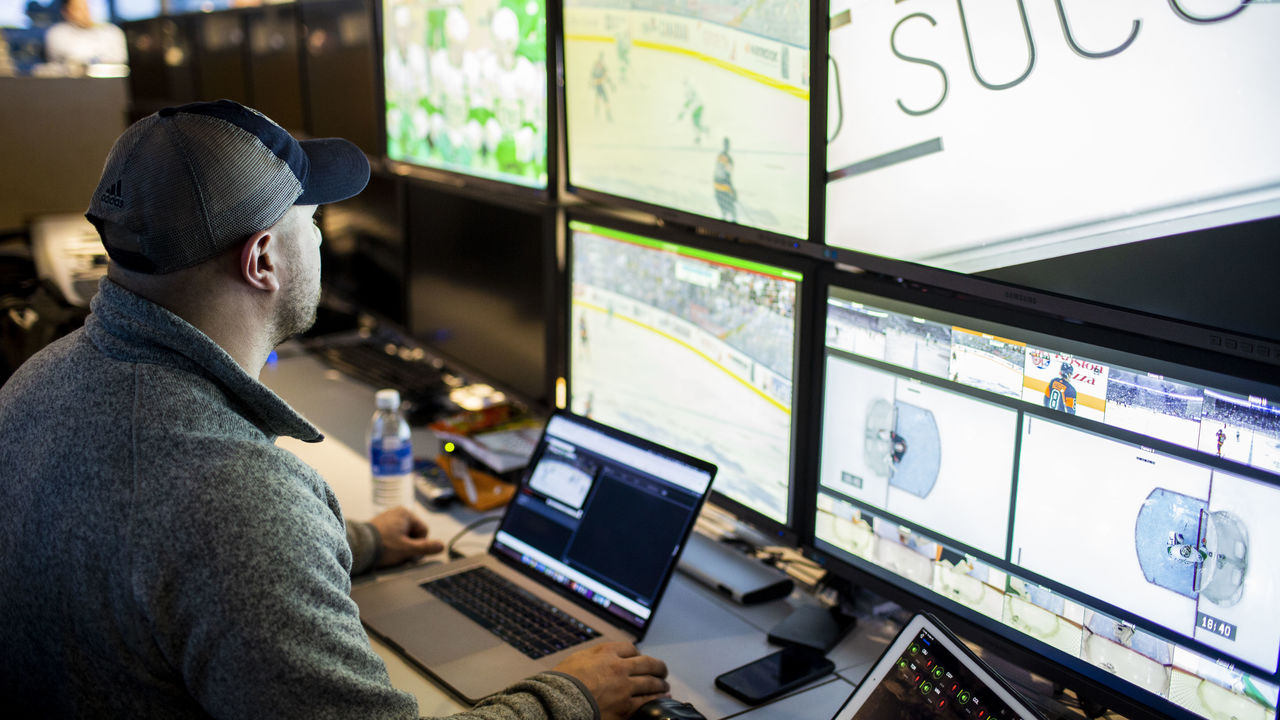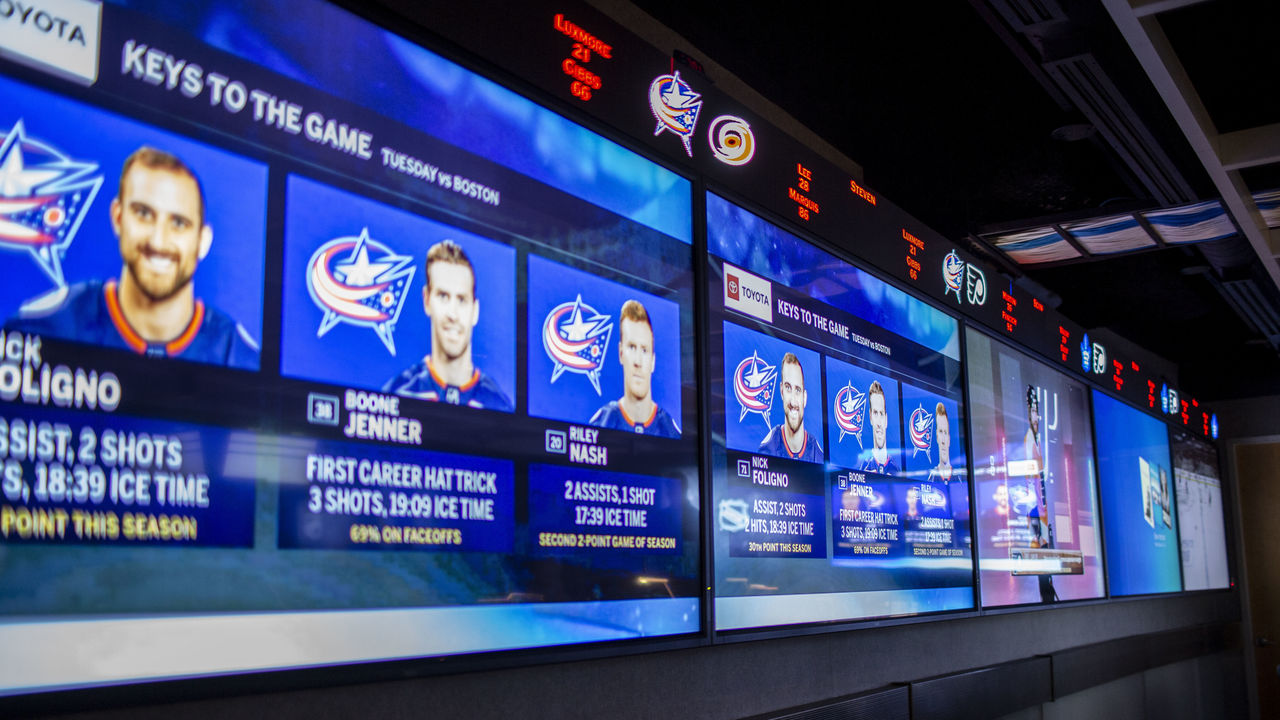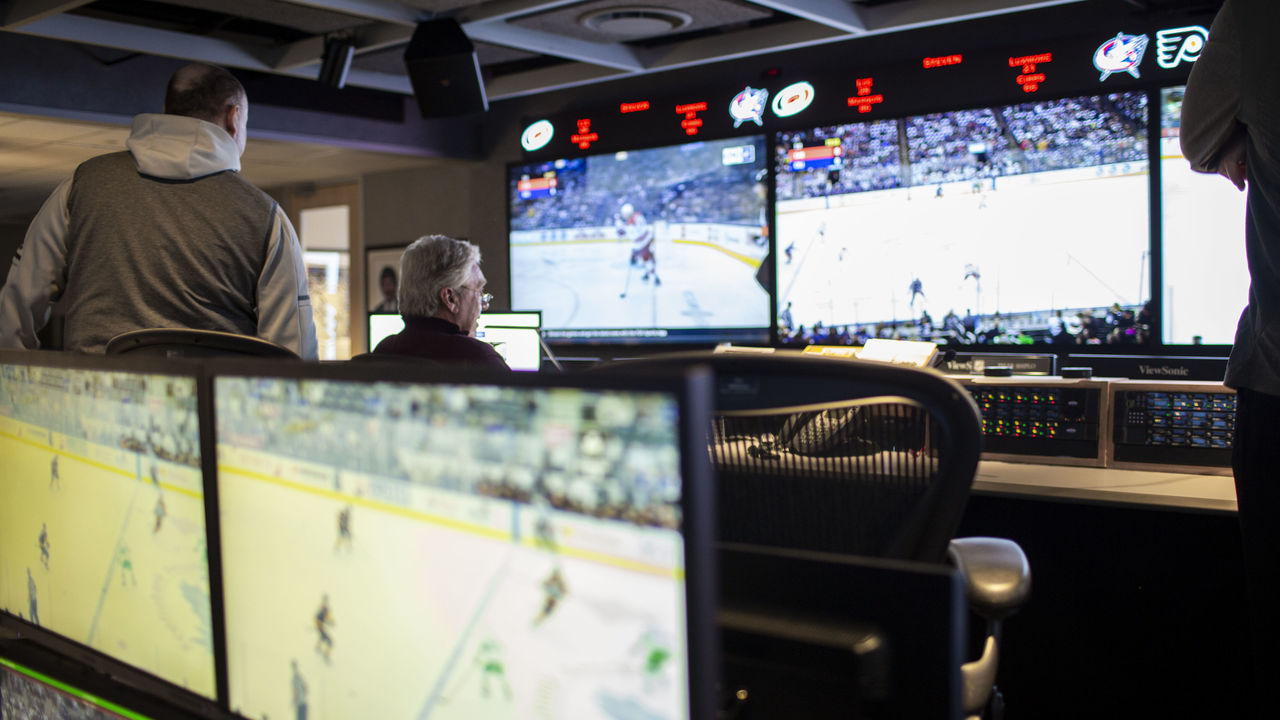Making calls on the calls: A night inside the NHL's Situation Room
TORONTO - It's a Friday evening in the Center of the Hockey Universe and thousands of Maple Leafs fans are streaming into Gate 1 at Scotiabank Arena. They gab and laugh, weaving through a tight hallway. It's nearly go time for a St. Patrick's Day weekend matchup against the Flyers.
Next door, on the 10th floor of 50 Bay Street, home of the National Hockey League offices, Sean Ellis settles in for the night. Four TV monitors, a laptop, an iPad, an iPhone, a TV remote, a computer mouse, a bottle of water, a sandwich, and a banana are all within reach. Like five other days this week and every week during the season, Ellis is in his element.

This is the workstation of a professional hockey watcher. "I couldn't think of a better job for myself," says Ellis, who's wearing an NHL-themed Patagonia sweater and a Winter Classic ball cap as he sits in his computer chair, his back to a view of the Toronto waterfront.
Pro hockey was the dream when Ellis, who hails from Massachusetts, graduated from Amherst College in 2007. He dressed for five preseason games in the Central Hockey League, hit the waiver wire, and decided to turn the page. "It was pretty disappointing," the 35-year-old admits. " ... But if it meant I wouldn't have this job, I'd choose this every time."
A decade later, Ellis holds the title of senior director of hockey operations for the NHL. He's a key member of a group that, among other duties, audits games in real time from the Situation Room, the league's center for quality control.
Not to be confused with the Department of Player Safety - the NHL's New York-based disciplinary arm - the Situation Room reviews disputed on-ice events such as goals, offsides, and goalie interference. Ellis and his colleagues are responsible for handling coach's challenges and, in general, maintaining the integrity of the game.
On March 15, as the Leafs and Flyers skated before 19,290 fans a short walk away, the NHL granted theScore entry into the Situation Room. Here's what we learned from our trip behind the scenes.
__________
The Situation Room traces its origins back to an angry phone call from Ken Holland in 2002. The longtime Red Wings general manager rang the league in the middle of a Wings-Flames game to vent about a gaffe by the on-site goal judge in Calgary.
"You guys have to do something about this! This is wrong!" Holland said, as retold by Mike Murphy, the NHL's senior vice president of hockey operations. "We can't have amateurs and part-time people making calls on those games!"
At the next GM meetings, the idea of creating a centralized video room was tabled. That discussion eventually led the NHL to grant select employees final authority on plays that were deemed reviewable. Starting in 2003, all concerns were directed to a dedicated unit of professionals in Toronto, rather than a local part-timer who had the emotionally involved parties - like Holland and his GM peers, along with coaches, players, and fans - breathing down their neck.
"This room's in a bubble. You're insulated from that type of abuse and that type of problem. At the rink you can get influenced by the pressure of the crowd, the pressure of the general manager," Murphy says with the start of the Leafs-Flyers broadcast in his peripheral vision. "That was the creation of this, and it's just exploded with more technology. TiVo, high-definition TV, fiber optics … "

On this particular night, Murphy and VP of hockey ops Rod Pasma man the bridge, an elevated strip inside the Situation Room. Five 90-inch screens are mounted at the head of the room. Above those screens, a ticker displays the operators and on-ice officials assigned to each active game. Monitors on a side wall ensure there's no shortage of visual aids.
On either side of the bridge sit the video room operators, part- and full-time NHL employees who inspect games. The operators have instant access to 14 camera angles, some of which are exclusive to the Situation Room, and they're trained to follow what other people aren't watching.
Ellis' spot is in the back row, a few seats away from Don Van Massenhoven. The longtime referee is part of a rotation of retired officials added to the group this season to supplement the review process. Their expertise lends a unique perspective and an extra layer of insight.
At around 7:35 p.m., with the Leafs and Flyers tied 1-1, the room comes alive.
Auston Matthews has batted a puck past Flyers goalie Brian Elliott in the final minute of the first period. On the ice, it's called a goal by head ref Dean Morton.
"Oh!" Pasma yells. "The net's off," Ellis says calmly, defining the issue. "Is it really?" Murphy asks. "Before it goes in?"
Within seconds, Pasma initiates review protocol, sending a signal to the off-ice official stationed between the penalty boxes inside Scotiabank Arena. A red strobe light flashes at ice level and a man picks up the phone. "Hey Luke, it looks like we might have a net off here … "
As Pasma, Murphy, and Van Massenhoven watch the sequence from numerous angles, Ellis transfers footage of the play to an iPad that can be viewed by the referees inside the arena. Morton picks up the tablet, puts on a headset, and links up with Pasma for a chat.
"Whaddaya got, Morty?" Pasma asks.
"We've got a good goal. Matthews bats the puck … (The Flyers are) talking about the net being off. I don't have the net moving at all until maybe after the play? And it looked like it was in play even when Matthews was batting away at the side of the net."
"Yeah. From where you are, Morty, it's hard to see because Elliott's pad's on it, but this net is definitely off the moorings before he shoots it in. OK? So, the net is off. This is no goal, Morty."
"So, we've got no goal. It wasn't continuous action and the Flyers did not bat it in?"
"That's exactly right. We looked at that, too, Morty. He shoots it well after the net's off."
"OK, so we've got no goal. The net was off its moorings prior to the puck crossing the line. OK, thank you."
Headset off, Morton delivers the verdict to the Toronto crowd. Matthews rolls his eyes. As a chorus of boos drowns out Morton's final words and social media reacts to the decision, the Situation Room launches into Phase 2: educating the hockey world.
The league's communications and public relations departments have been involved in the review process to varying degrees since the 2009 playoffs. In the moments following the Matthews decision, Corey Dempsey, an in-game communications employee, has already typed a rough draft laying out the Situation Room's reasoning for overturning the call on the ice.
PR colleague Trevor Bjergso consults with Dempsey, who has a Word doc open for Pasma's approval. Making his way over from the bridge, Pasma recites exact wording for one particular part of the draft. The language is important. Dempsey reads the passage back to Bjergso, Pasma, and Murphy. He gets the green light from his superiors. It's ready for public consumption.
The explanation is emailed to the PR departments for the Leafs and Flyers, as well as regional and national broadcasting partners. Roughly 10 minutes after Pasma's headset discussion with Morton, the rationale is published on NHL.com and fed through the league's social media channels. "The room's evolved," Pasma says, "into this real-time information generator."
Murphy connects via phone with his boss, executive VP of hockey ops Colin Campbell, who is working from his home in the southwestern Ontario farm town of Tillsonburg. In great detail, they discuss a potential issue with the nets in the Leafs' home rink. Toronto was on the wrong side of another goal review earlier in the week, and in both instances, the net seemed to be rather easily dislodged.
Pasma joins the conversation and the three higher-ups toss around several theories. Nothing official is being decided, but there's a strong sense of curiosity. They'd like to be proactive. So, what's really going on? Are the pegs used to secure the nets not gripping the ice? Is this actually an issue? If so, how can it be fixed?
This back-and-forth is a prime example of the Situation Room's influence on the game of hockey, which extends far beyond a goal review on a Friday night in mid-March. In the moment, the group is beholden to the rule book and errs on the side of caution. There are no knee-jerk reactions. However, the room often serves as a think tank for improving the on-ice product.
"Snow gets in there and either messes with the integrity of the peg or keeps it from going down. Something. When our ice crews go out, clean the holes out, put the pegs back in," Pasma says to Campbell and Murphy at one point. The pair clearly agreed. On Saturday, the hockey ops department emails a memo to arena crews across the league, encouraging them to pay closer attention to the stability of the nets.
Much like the dynamic within the Situation Room itself, the NHL's hockey ops department tries its best to operate democratically over the medium and long terms. The GMs, on the whole, act as the Situation Room's "compass," Pasma says, but the line of communication is always open.
"A lot of times, if we have a lot of contentious plays, we'll take them to the managers meetings," he continues, emphasizing the collaborative approach of the NHL's major off-ice influencers. "Here's the play, here's our ruling on it, here's why we ruled on it, can you tell us what you guys think?"
__________
There was a time when the NHL's hockey ops department only ruled on player safety issues, handing down suspensions for biting, spearing, and other egregious acts. Murphy, the 68-year-old former player and coach, laughs when he remembers attempting to review footage on the fly with 12-inch TVs and VHS tapes.
"If you saw something, you'd have to wait for a commercial break and then hurry back to the right spot (in the tape)," he says, recalling having to FedEx the cassettes to Campbell's home. "And then you'd hurry forward to reset it so you wouldn't miss the game."

In 2019, the player safety department and the Situation Room operate completely independently from each other, and the latter's considered innovative in the pro sports landscape. Of course, it helps that the technology has improved immensely, solidifying and streamlining the review process.
Next season, player and puck tracking will be rolled out on a full-time basis, adding a new tool to the technological arsenal. Will it dramatically affect the Situation Room? As of now, it's tough to say.
"There are times where we lose a puck in the goalie's equipment - under a pad - and you think it may be in the net but you can't be 100 percent sure. Or it goes into his glove and you think it's across the goal line. I think tracking may help in that area," Pasma says. He also thinks it could, hypothetically, help in the realm of high-stick goals too.
But there are no guarantees with new tech. And for the Situation Room's inhabitants, that's part of the fun. The NHL's rules will forever be tweaked, its production quality always improved, yet the group's collective dedication to "getting it right" simply cannot slip.
On this particular Friday night, Ellis hops into his car well after midnight following a second game plus some additional Situation Room duties. With Leafs fans long gone from Scotiabank Arena and the weekend's Irish-themed festivities in full swing, the professional hockey watcher drives some 100 kilometers to his home in Cambridge, Ontario. He'll complete the same commute again and again and again, logging more than 400 games a year.
Not a bad gig for a guy who couldn't crack the Central Hockey League.
"At times, like in February and March, it can really feel like it's dragging. But you just need one game where something big happens and you snap out of it," Ellis says. "You walk away at the end of the night and remember how lucky you are to get to do this."
John Matisz is theScore's National Hockey Writer. You can find him on Twitter @matiszjohn.
HEADLINES
- Leafs fire assistant coach Savard amid NHL-worst power play
- Hurricanes' Jarvis, Slavin week-to-week with upper-body injuries
- Raddysh's 3-point night pushes Lightning past Blues
- Kraken's Montour expected to miss about 4 weeks after hand surgery
- Crosby after passing Lemieux: 'In my mind, he's still No. 1'